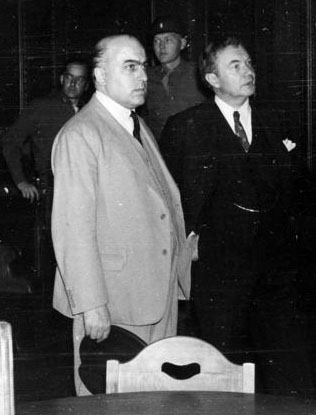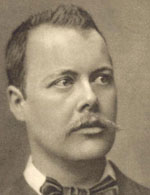["No, I want you to tell me how it is pronounced", IMT X, p. 214]!

Fyfe and Jackson, shyster lawyers and linguistic illiterates
THE MYTH OF KADAVERGEHORSAM ("corpse-like obedience")
Except for lower-level interrogators, interpreters and translators, the men who tried representatives of the German nation for "war crimes" at Nuremberg and elsewhere had no knowledge of the German language, a shortcoming so serious that Sir David Maxwell-Fyfe even had to ask one of the witnesses at Nuremberg how to pronounce the name of a relatively well-known Austrian château and resort, Schloss Fuschl, on Lake Fuschl, near Salzburg.
["No, I want you to tell me how it is pronounced", IMT X, p. 214]!

Fyfe and Jackson, shyster lawyers and linguistic illiterates
To remedy this deficiency, at least in the their own eyes, these same men constantly larded their perorations and political speeches in court with a sprinkling of German words which they had no doubt learned parrot-like for the purpose (probably fewer than five words in total). One of these words was "Kulturträger" ("culture-bearer"), a great favourite of the Soviets, who inserted it ironically in many of their "anti-fascist" atrocity stories. Among the Anglo-Saxon prosecutors, the all-time favourite, still commonly found in "anti-fascist" literature today, is the word "Kadavergehorsam".
The term "Kadavergehorsam", allegedly a German word, was utilized to "prove" that wooden, unthinking, "corpse-like" obedience is a characteristic of the German nation, or, more specifically, National Socialists and "Prussian militarists" generally.
As usual, of course, the very word itself is a fraud. "Kadavergehorsam" is simply a translation from Latin of a Jesuit motto originating with St. Ignacio de Loyola, usually, if not always, taken out of context. The Latin phrase is "Perinde ac cadaver...... " ("like a corpse").

Ignacio de Loyola, Basque soldier of fortune and founder of the Jesuits
As an accusation against Prussian militarists and National Socialists, this is already a bit thick. Even in Latin, it is probably one of the most famous "quotations-out-of-context" in all literature.
The phrase was made famous by Houston Stewart Chamberlain in "The Foundations of the 19th Century", in an alleged attempt to argue that the principle of "corpse-like obedience" is of Basque origin, and is therefore non-Aryan.
(NOTE: Chamberlain seems to be using the word "Aryan" here as a linguistic term, and not a racial term, thus adding to the confusion. - C.P.)
The quotation according to Chamberlain is as follows: “as if it were a corpse which lets itself be turned on any side and never resists the hand laid upon it, or like the staff of an old man which everywhere helps him who holds it, no matter how and where he wishes to employ it. [“Perinde ac si cadaver essent, quod quoquoversus ferri, et quacunque ratione tractare se sinit: vel similiter atque senis baculus, qui obicumque et quacumque in re velit eo uti, qui cum manu tenet, ei inservit.“]". Chamberlain continues: "I think it would be impossible to make the contrast to all Aryan thought and feeling more clear than it is in these words: on the one hand sunny, proud, mad delight in creating, men who fearlessly grasp the right hand of the God to whom they pray; on the other a corpse, upon which the “destruction of all independent judgment“ is impressed as the first rule in life and for which “cowering slavish fear“ is the basis of all religion (p. 243)."

Houston Stewart Chamberlain, racial theorist
The great Basque writer, Pío Baroja, hardly a friend of the Jesuits, or even Catholics or Christians generally, says, "This statement is tendentious and false. First, Loyola did not say that one had to obey like a corpse. He said, "Perinde ac cadaver in omnibus ubi peccatum non cerneretur" (to obey like a corpse in all matters in which one does not fall into sin). Loyola could not have translated this into Basque without using words of Latin origin. It was not, therefore, of Basque origin" ( from "Los Jesuitas", in "Vitrina Pintoresca", a collection of essays published in 1935; p. 739, Vol. V, Obras Completas, Biblioteca Nueva, Madrid.)

Pío Baroja, ex-physician and Basque personification of curmudgeonly cantankerousness and sarcasm;
one of the world's best-selling authors in Spanish
If Baroja is correct, the phrase plainly implies that obedience to a sinful order is not required. Since the person receiving the order is the only one who can, and must, for the sake of his own soul, determine whether or not an order is "sinful" (or "illegal"), this could be interpreted to mean that, ultimately, there is no duty of absolute obedience at all, which, taken to the other extreme, is more or less unworkable -- i.e., pure Nuremberg, a principle invented solely for export.
Of course, that is undoubtedly not the meaning either. So that, as so often, the phrase itself becomes more or less meaningless depending on how it is interpreted. And this is taken as "proving" the "corpse-obedience" of German patriots interpreted by people who cannot read German!
Obviously, to form a correct interpretation of the principle as applied by the Jesuits, would require a complete knowledge of Jesuit literature, i.e., the full context (probably Loyola's "Letter on Obedience"). In this sense, Baroja was probably right.
"Loyola distinctly excepts the case where obedience in itself would be sinful: 'In all things except sin I ought to do the will of my superior and not my own.'... [deletion: description of list of procedures to be followed by a subordinate afraid that an order might be sinful, etc.etc.]
"
From this it is clear that only in doubtful cases concerning sin should an inferior try to submit his judgement to that of his superior, who ex officio is held to be not only one who would not order what is sinful, but also a competent judge who knows and understands, better than the inferior, the nature and aspect of the command. As Jesuit obedience is based on the law of God, it is clearly impossible that he [the subordinate] should be bound to obey in what is directly opposed to divine service." (1911 Encyclopaedia Britannica, "Jesuits", Vol. 15, p. 338).
The Jesuits have probably been the victim of more forgeries and quotations out of context than any group of people in history except the National Socialists, whom they in certain respects rather resemble. The most famous of these forgeries is probably the Monita Secreta, published in 1612.
In any case, the term "Kadavergehorsam" has no place in a trial of modern Germans.
This is simply one more example of the fraudulence of all Nuremberg proceedings. If a "trial" were required, it could have been held in Switzerland, a German-speaking, neutral country, under existing law, eliminating the need for interpreters and translators almost entirely.
C.PORTER
15 MARCH 2007
P.S. Another favourite trick was to make political speeches quoting Goethe and Shakespeare (and God knows what all else for thousands of pages). How does one prove someone guilty of murder in the 20th century by quoting MacBeth or Richard III? Then, when the defense came up with some real evidence, like 312,022 notarized affidavits for the "criminal organizations", sworn according to COURT-ORDERED AMERICAN PROCEDURES, they were told that the court "didn't have time" to translate and read them! So much for justice.
References:
The defense evidence for the "criminal organizations" consists of the testimony of 102 witnesses and 312,022 notarized affidavits (XXII 176 [200]).
The term "criminal" was never defined (XXII 310 [354]; see also XXII 129-135[148-155]).
Nor was it defined when these organizations became "criminal" (XXII 240 [272-273]).
The Nazi Party itself was criminal dating back to 1920 (XXII 251 [285]) or then again maybe only1938 (XXII 113 [130]) or maybe even not at all (II 105 [123]).
The 312,022 notarized affidavits were presented to a "commission", and evidence before this "commission" does not appear in the transcript of the Nuremberg Trial. The National Archives in Washington do not possess a copy of the commission transcript, had never heard of it when I asked, and did not know what it is.
Of the 312,022 affidavits, only a few dozen were ever translated into English, so the Tribunal could not read them (XXI 287, 397-398 [319, 439]). The President of the Tribunal, Sir Geoffrey Lawrence, understood no German; neither did Robert Jackson.
Due to a last-minute rule change (XXI 437-438, 441, 586-587 [483-485, 488,645-646]) many more affidavits were rejected on technical grounds (XX 446-448 [487-489]).
The "commission" prepared "summaries" which were presented to the Tribunal (x-thousand affidavits alleging humane treatment of prisoners, etc). These summaries were not considered to be in evidence. The Tribunal promised to read the 312,022 affidavits before arriving at their verdict (XXI 175 [198]); 14 days later it was announced that the 312,022 affidavits were not true (XXII 176-178 [200-203]).
Then a single affidavit from the prosecution (Document D-973) was deemed to have "rebutted" 136,000 affidavits from the defense (XXI 588;437, 366 [647, 483-484, 404]).
The 102 witnesses were forced to appear and testify before the "commission" before appearing before the Tribunal. Then, 29 of these witnesses (XXI 586 [645]), or 22 of these witnesses (XXII 413 [468]) were allowed to appear before the Tribunal, but their testimony was not permitted to be 'cumulative', that is, repetitive of their testimony before the 'commission' (XXI 298, 318, 361 [331, 352, 398-399]).
Then, six affidavits from the prosecution were deemed to have "rebutted" the testimony of the 102 witnesses (XXI 153 [175], XXII 221[251]).
One of these affidavits was in Polish, so the defense could not read it (XX 408 [446]). Another was signed by a Jew named Szloma Gol who claimed to have dug up and cremated 80,000 bodies, including that of his own brother (XXI 157 [179], XXII 220 [250]).
(In the British transcript he has only dug up 67,000 bodies). The prosecution had already rested its case when this occurred (XX 389-393, 464 [426-430, 506]; XXI 586-592 [645-651]). The prosecution then claimed in its final summation that 300,000 affidavits had been presented to the Tribunal and had been considered during the trial, giving the impression that these are prosecution documents (XXII 239 [272]).
In fact, the prosecution got through the entire trial with no more than a few really important affidavits of their own. (See, for example, XXI 437 [483], where eight or nine affidavits were presented for the prosecution against three hundred thousand for the defense; see also XXI 200 [225]; 477-478 [528-529]; 585-586 [643-645]; 615 [686-687]).
In the various concentration camp trials, such as the Trial of Martin Gottfried Weiss, a simpler expedient was agreed upon: mere employment in the camp, even if only for a few weeks, was deemed to constitute "constructive knowledge" of the "Common Plan". "Common Plan", of course, was not defined. It was not necessary to allege specific acts of mistreatment, or to show that anyone had died as a result of mistreatment. (36 of the 40 defendants were sentenced to death.)
The transcript of the Nuremberg commission is in The Hague, and fills half of one fire-proof floor-to-ceiling vault. The testimony of each witness was typed with a pagination beginning with page 1, then re-typed, with consecutive pagination running to many thousands of pages.
The first drafts and clean copy are in folders, together, stapled, on very brittle paper, with rusty staples. It is absolutely certain that, at least at The Hague, no one has ever read this material.
See also:
The Myth of the "Master Race" by C.W. Porter
The Myth of the "Thousand Year Reich" (about half-way down
THE MYTH OF "A THOUSAND YEARS WILL PASS"
Return to CONTENTS PAGE